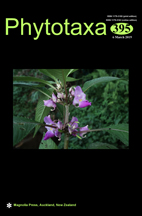Abstract
Sections of the paraphyletic genus Batrachospermum have been recently investigated using molecular (DNA sequence data) and morphological evidence. Some sections have been recognized as distinct genera in order to resolve paraphyly. Batrachospermum species of sections Acarposporophytum and Aristata are showed to form well-supported clades and, in this study, we propose to raise them to the generic level, Acarposporophycos gen. nov. and Visia gen. nov., respectively. In addition, we re-evaluated the characters used to circumscribe species by reexamining type specimens as well as new collections. Acarposporophycos, with the sole species A. brasiliensis, is characterized by the lack of carposporophytic stage, with the fertilized carpogonia germinating to form directly the filaments of the ‘Chantransia’ stage on the gametophyte. Of the five previously accepted species in the genus Visia, we recognize four species: V. cayennensis—type species (synonym Batrachospermum beraense), V. cylindrocellularis, V. longiarticulata and V. turgida. The species are circumscribed on the basis of morphological characteristics (shape and cell layers of primary fascicles, occurrence of secondary fascicles, post-fertilization development of carpogonia) and DNA sequence data (rbcL and COI-5P). Specimens described as Visia cayennensis from Australia and Brazil had a high sequence divergence in comparison to those from or near the type locality (French Guiana), and are here referred to as Visia spp. Further studies are recommended to better discriminate these morphologically similar species on a broad geographical scale and define their status at the species level. Descriptions, identification key and photomicrographs are presented for each recognized species.

